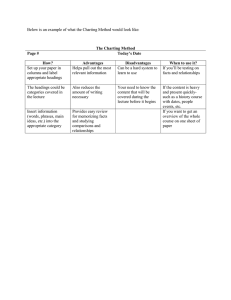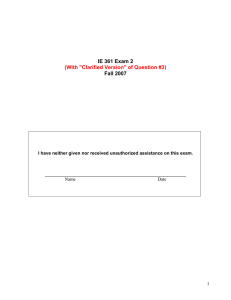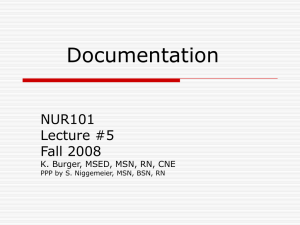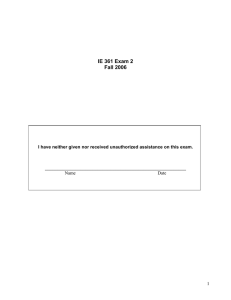IE 361 Exam 2 Fall 2009
advertisement
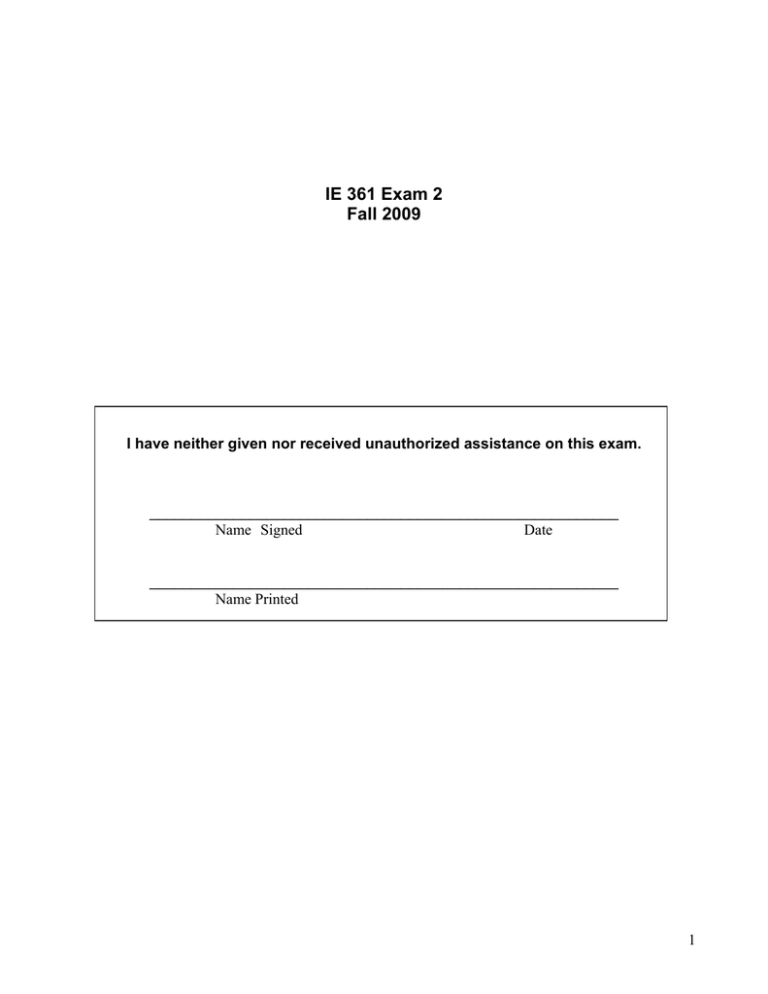
IE 361 Exam 2 Fall 2009 I have neither given nor received unauthorized assistance on this exam. ________________________________________________________ Name Signed Date ________________________________________________________ Name Printed 1 This exam consists of 20 multiple choice questions. There is a single best answer for each question. Circle EXACTLY ONE response for each question on this answer sheet. 1. A B C D E 2. A B C D E 3. A B C D E 4. A B C D E 5. A B C D E 6. A B C D E 7. A B C D E 8. A B C D E 9. A B C D E 10. A B C D E 11. A B C D E 12. A B C D E 13. A B C D E 14. A B C D E 15. A B C D E 16. A B C D E 17. A B C D E 18. A B C D E 19. A B C D E 20. A B C D E 2 1. "Special cause variation" a) is exactly that kind of process variation that control charting is meant to detect. b) must be eliminated by appropriate process intervention in response to "out of control" signals before it makes sense to think of a process as physically stable. c) is also known as "random" variation. d) All of responses a) through c) are correct completions of the sentence. e) Exactly 2 of responses a) through c) are correct completions of the sentence. 2. In a case where individual measurements x are to be plotted on a control chart (the plotted statistic is just Q = x ) • standards given control limits should be based on engineering specifications. • one is essentially operating an x chart with n = 1 . • retrospective control limits should be set at the average measurement plus or minus three times the grand sample standard deviation of the measurements. • engineering specifications for x can be derived from the plotted values as long as no out-ofcontrol signals are issued. a) None of the above is a correct completion of the sentence. b) Exactly one of the above is a correct completion of the sentence. c) Exactly two of the above are correct completions of the sentence. d) Exactly three of the above are correct completions of the sentence. e) All of the above are correct completions of the sentence. 3. Every morning before a day's work begins in a testing lab, the same standard specimen is tested on a particular laboratory instrument. The single measured value produced is then plotted on a control chart with control limits set at (true value for the standard specimen) ± 3σ measurement (the value of σ measurement was derived from repeated measurement of the standard specimen in a single session). This practice • is a form of "measurement process" monitoring. • is primarily effective at detecting a change in the instrument's bias, but can be expected to also eventually detect a degradation in instrument precision. • could be made more practically useful by replacing standards-given charting with retrospective charting. • is intended to detect a change in behavior of the instrument. a) None of the above is a correct completion of the sentence. b) Exactly one of the above is a correct completion of the sentence. c) Exactly two of the above are correct completions of the sentence. d) Exactly three of the above are correct completions of the sentence. e) All of the above are correct completions of the sentence. 4. Large sample sizes in control charting a) allow relatively quick detection of relatively small process changes. b) are relatively expensive. c) are essential to guarantee high rates of conformance to engineering specifications. d) Exactly 2 of a), b), and c) are correct completions to the sentence. e) All of a), b), and c) are correct completions to the sentence. 3 Below are sample means and standard deviations from 10 samples of size n = 6 . Use the information from these samples to answer questions 5 through 7. Sample x s 1 4.20 1.64 2 4.62 1.26 3 3.27 .72 4 6.27 1.19 5 4.96 2.11 6 7.31 2.10 7 6.77 2.03 8 6.99 1.87 9 5.58 1.96 10 8.41 1.93 Sum 58.38 16.81 5. Consider standards given control charting for both x and s , with standards μ = 5.0 and σ = 2.0 . a) The x chart and s chart both produce out-of-control signals. b) The x chart produces out-of-control signals, but the s chart does not. c) The x chart produces no out-of-control signals, but the s chart produces signals. d) Neither chart produces out-of-control signals. 6. Consider retrospective control charting for both x and s . a) The x chart and s chart both produce out-of-control signals. b) The x chart produces out-of-control signals, but the s chart does not. c) The x chart produces no out-of-control signals, but the s chart produces signals. d) Neither chart produces out-of-control signals. 7. Ignore any lack of stability that you found indicated by the s values above and use these values to make an estimate of σ . Based on this estimate, in turn set an upper control limit for future ranges ( R ) based on samples of size n = 4 . (Remember that the samples represented in the table were of size n = 6 .) This UCLR is closest to a) 3.84 b) 7.90 c) 8.30 d) 8.54 e) 8.97 8. Below are some statements about various kinds of "limits" encountered in a course like IE 361. How many of them are true? • Statistical tolerance limits change when engineering specification limits change. • 95% confidence limits for a process mean are inside 95% prediction limits for a new individual value from the process. • Standards given control limits for an n = 5 sample mean can also be used to make 99% predictions for a new individual value from the process. • Control limits concern the establishment of process stability, while the use of statistical prediction and tolerance limits assumes that stability is present. a) All 4 are correct. b) Exactly 3 are correct. c) Exactly 2 are correct. d) Exactly 1 is correct. e) None is correct. 4 In a project intended to eventually improve the operation of a large heating, ventilation, and air conditioning (HVAC) system, the numbers of alarms issued by CO 2 sensors in the system are recorded for 10 consecutive weeks and are reproduced below. Use this scenario and these data to answer questions 9 through 11. Week Sensor Alarms 1 2 3 4 5 6 7 8 9 10 Sum 4 5 4 10 6 8 7 7 7 6 64 9. The data in the table a) provide no evidence of change over time (variation) in the CO 2 sensor alarm rate in the 10 week period. b) provide clear evidence that the system is not operating consistently at a designed-for-rate of 2 sensor alarms per week. c) are an example of "mean non-conformities per unit" data. d) Exactly 2 of a) through c) are correct completions of the sentence. e) All of a) through c) are correct completions of the sentence. 10. In this context, any lack of process stability identified by process monitoring a) is potentially attributable to sensor failure during the period of study. b) is potentially attributable to a poor Engineering Feedback Control system that fails to keep CO 2 levels consistent across the period of study. c) is potentially attributable to changes in weather or building use patterns across the period of study. d) Exactly 2 of a) through c) are correct completions of the sentence. e) All of a) through c) are correct completions of the sentence. 11. If rather than charting sensor alarms per one week, in the future one will chart rates of occurrence for two-week periods total sensor alarms in a two-week period rate = 2 and using the data of the table above to set a standard occurrence rate, control limits for the future (two-week) rates a) can not be determined without some direct experience with two-week monitoring periods. b) are LCLrate = 1.03 and UCLrate = 11.77 . c) are no LCLrate and UCLrate = 13.99 . d) are LCLrate = 2.07 and UCLrate = 23.53 . e) None of a) through d) is a correct completion of the sentence. 5 12. Suppose that under standard process conditions, drips have been appearing in the final painting of a type of large farm implement at a rate of about .3 drips per unit. 50 of these units are produced per day. One might consider control charting either X = the number of units (out of 50) with at least one drip or Y = the total number of drips on all 50 units Below are some statements about standards-given control charting for this painting process. How many of them are true? • Charting for X is " np " charting. • Charting for Y is " c " charting. • A center line for charting with X should be at 12.96. • A center line for charting with Y should be at 15.00. a) All 4 are correct. b) Exactly 3 are correct. c) Exactly 2 are correct. d) Exactly 1 is correct. e) None is correct. Problems 13 and 14 concern the cutting of rolled paper into sheets. Suppose that a single revolving cylindrical cutter with two blades on it as pictured below is used to slice the rolled paper into sheets as the paper passes below the rotating cutter. Every hour, n = 10 consecutive sheets of paper are sampled from the cutting process and their lengths carefully measured for purposes of (cutting) process monitoring. Consider the possibility that the two blades are not perfectly positioned opposite each other (they are lined up with the cylinder axis, but are not exactly 180 degrees apart). 13. Below are several statements about this situation. How many of them are true in the event that there is important mis-positioning of the blades? • Consecutive sheet lengths will tend to oscillate up and down. • If the 10 sheets from any particular hour are treated as a single sample of size 10, this scenario is one involving "stratification." • There is not really a single sheet cutting process at work, but rather two such processes. • The practical difficulty of determining which of the two blades cuts a given sheet off the paper roll makes it practically impossible to separately monitor the operation of the two blades. a) All 4 are correct. b) Exactly 3 are correct. c) Exactly 2 are correct. d) Exactly 1 is correct. e) None is correct 6 14. An engineer faced with this problem suggests breaking every set of 10 consecutive sheets sampled into pairs of consecutive sheets and for each pair computing both z = the average of the two measured sheet lengths for the pair and w = the range of the two consecutive sheet lengths In this context, one might consider control charting with samples of ( n = 5 ) z's and samples of ( n = 5 ) w's . Here a) " x " charting applied to z's monitors the average amount of paper required to produce a sheet. b) " x " charting applied to w's monitors one kind of inconsistency in sheet lengths. c) " R " charting applied to the z's monitors one kind of inconsistency in sheet lengths. d) Exactly 2 of a) through c) are correct completions of the sentence. e) All of a) through c) are correct completions of the sentence. 15. It is fashionable in "Six Sigma" circles to insist that a successful company's nonconforming rates should be small numbers of "parts per million" (for example, p = 1× 10−6 ). Consider p charting based on the "large" sample size of n = 100 . You may take as given the facts that such a chart (with given standard p = 1× 10−6 ) signals lack-of-control exactly when the sample contains at least on nonconforming item, and that the ARL for such a scheme is about 1000 if it is the case that p = 10−5 . a) These calculations suggest that only smaller (than the change to 10−5 ) changes from p = 10−6 will be quickly detected by attributes control charting. b) These calculations indicate that a p chart for n = 100 will be an effective tool for detecting a 10fold multiplication of a "parts per million" fraction non-conforming. c) These calculations suggest that process monitoring for "parts per million" rates based on attributes data and reasonable sample sizes is a hopeless proposition. d) These calculations suggest nothing about the likely effectiveness of attributes control charting in parts per million contexts. e) None of a) through d) is correct. 16. Process capability indices C p and C pk • a) b) c) d) e) are both one-number summaries of the relationship between process parameters and the engineering specifications. • are both typically poorly estimated/determined on the basis of small samples. • are respectively measures of process potential and current process performance. • both really only have natural/useful interpretations in cases where process output is normally distributed. All 4 of these completions of the statement are correct. Exactly 3 of these completions of the statement are correct. Exactly 2 of these completions of the statement are correct. Exactly 1 of these completions of the statement is correct. None of these completions of the statement is correct. 7 17. Below is a normal plot of measured contamination levels from n = 120 chemical samples. a) This plot suggests that the distribution of contamination levels is fairly symmetric. b) This plot suggests that the center of the contamination level distribution is around 10. c) This plot suggests that relative to the shape of the normal distribution, the distribution of contamination levels has fewer extreme values/lighter tails. d) All of statements a) through c) are correct. e) Exactly 2 of statements a) through c) are correct completions of the sentence. Lengths (in cm) in a batch of n = 19 kitchen worktops have x = 120.005 cm , s = .015 cm , min xi = 119.96 cm , and max xi = 120.04 cm . Specifications on this dimension of these worktops are 120.00 ± .15 cm and we'll suppose that the process used to make them is physically stable. Use these facts to answer questions 18 through 20. 18. How "sure" should one be that at least 90% of worktops will have lengths between 119.96 cm and 120.04 cm ? a) 95% b) 90% c) 86% d) 58% e) None of the above are close to correct (say within 2% of the correct value). 8 19. Assuming worktop length to be normally distributed, 95% confidence limits for 6σ for manufactured worktop length a) are .68 cm and 1.33 cm and indicate that the process does not have the potential to meet specifications. b) are .68 cm and 1.33 cm and indicate that the process has the potential to meet specifications. c) are .068 cm and .133 cm and indicate that the process does not have the potential to meet specifications. d) are .068 cm and .133 cm and indicate that the process has the potential to meet specifications. e) tell one nothing about process capability. 20. Again assuming worktop length to be normally distributed, one can be 95% sure that the next worktop produced has length a) between values 120.005 ± 2.101(.0034 ) cm . b) between values 120.005 ± 2.101(.0150 ) cm . c) between values 120.005 ± 2.101(.0154 ) cm . d) between values 120.005 ± 2.793 (.0150 ) cm . e) None of the above are close to correct. 9
